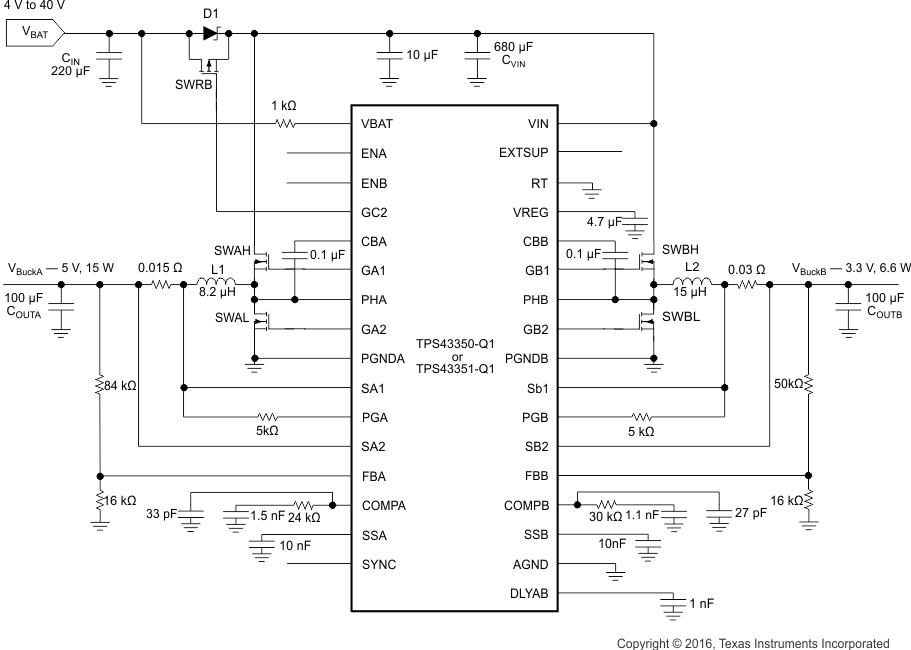SLVSAR7E June 2011 – October 2016 TPS43350-Q1 , TPS43351-Q1
PRODUCTION DATA.
- 1 Features
- 2 Applications
- 3 Description
- 4 Revision History
- 5 Pin Configuration and Functions
- 6 Specifications
-
7 Detailed Description
- 7.1 Overview
- 7.2 Functional Block Diagram
- 7.3
Feature Description
- 7.3.1
Buck Controllers: Normal Mode PWM Operation
- 7.3.1.1 Frequency Selection and External Synchronization
- 7.3.1.2 Enable Inputs
- 7.3.1.3 Feedback Inputs
- 7.3.1.4 Soft-Start Inputs
- 7.3.1.5 Current-Mode Operation
- 7.3.1.6 Current Sensing and Current Limit With Foldback
- 7.3.1.7 Slope Compensation
- 7.3.1.8 Power-Good Outputs and Filter Delays
- 7.3.1.9 Light-Load PFM Mode
- 7.3.2 Frequency-Hopping Spread Spectrum (TPS43351-Q1 Only)
- 7.3.3 Gate-Driver Supply (VREG, EXTSUP)
- 7.3.4 External P-Channel Drive (GC2) and Reverse-Battery Protection
- 7.3.5 Undervoltage Lockout and Overvoltage Protection
- 7.3.6 Thermal Protection
- 7.3.1
Buck Controllers: Normal Mode PWM Operation
- 7.4 Device Functional Modes
-
8 Application and Implementation
- 8.1 Application Information
- 8.2
Typical Application
- 8.2.1 Design Requirements
- 8.2.2
Detailed Design Procedure
- 8.2.2.1 BuckA Component Selection
- 8.2.2.2 Inductor Selection L
- 8.2.2.3 Inductor Ripple Current IRIPPLE
- 8.2.2.4 Output Capacitor COUTA
- 8.2.2.5 Bandwidth of Buck Converter fC
- 8.2.2.6 Selection of Components for Type II Compensation
- 8.2.2.7 Resistor Divider Selection for Setting VOUTA Voltage
- 8.2.2.8 BuckB Component Selection
- 8.2.2.9 Resistor Divider Selection for Setting VOUT Voltage
- 8.2.2.10 BUCKx High-Side and Low-Side N-Channel MOSFETs
- 8.2.3 Application Curves
- 9 Power Supply Recommendations
- 10Layout
- 11Device and Documentation Support
- 12Mechanical, Packaging, and Orderable Information
Package Options
Mechanical Data (Package|Pins)
- DAP|38
Thermal pad, mechanical data (Package|Pins)
- DAP|38
Orderable Information
8 Application and Implementation
NOTE
Information in the following applications sections is not part of the TI component specification, and TI does not warrant its accuracy or completeness. TI’s customers are responsible for determining suitability of components for their purposes. Customers should validate and test their design implementation to confirm system functionality.
8.1 Application Information
The TPS4335x-Q1 devices are dual synchronous buck controllers used to convert a higher-input voltage to two lower-output voltages. The following sections have the component values and calculations that are a good starting point for use in the application. Some of the values in the equations are theoretical values, to improve the performance of the device may require further optimization of these values.
8.2 Typical Application
8.2.1 Design Requirements
Table 3 lists the design-goal parameters.
Table 3. Design Parameters
8.2.2 Detailed Design Procedure
The following example illustrates the design process and component selection for the TPS43350-Q1.
This is a starting point, and theoretical representation of the values to be used for the application; improving the performance of the device may require further optimization of the derived components.
Table 4. Application Example – Component Proposals
| NAME | COMPONENT PROPOSAL | VALUE |
|---|---|---|
| L1 | MSS1278T-822ML (Coilcraft) | 8.2 µH |
| L2 | MSS1278T-153ML (Coilcraft) | 15 µH |
| D1 | SK103 (Micro Commercial Components) | |
| SWRB | IRF7416 (International Rectifier) | |
| SWAH, SWAL, SWBH, SWBL | Si4840DY-T1-E3 (Vishay) | |
| COUTA, COUTB | ECASD91A107M010K00 (Murata) | 100 µF |
| CIN | EEEFK1V331P (Panasonic) | 330 µF |
8.2.2.1 BuckA Component Selection
8.2.2.1.1 Minimum ON Time, tON min

This is higher than the minimum on-time specified (100 ns typical). Hence, the minimum duty cycle is achievable at this frequency.
8.2.2.1.2 Current-Sense Resistor RSENSE
Based on the typical characteristics for VSENSE limit with VIN versus duty cycle, the sense limit is approximately 65 mV (at VIN = 12 V and duty cycle of 5 V / 12 V = 0.416). Allowing for tolerances and ripple currents, choose VSENSE with a maximum of 50 mV.

Select 15 mΩ.
8.2.2.2 Inductor Selection L
As explained in the description of the buck controllers, for optimal slope compensation and loop response, the inductor should be chosen such that:

KFLR = Coil selection constant = 200
Choose a standard value of 8.2 µH. For the buck converter, the inductor saturation currents and core should be chosen to sustain the maximum currents.
8.2.2.3 Inductor Ripple Current IRIPPLE
At nominal input voltage of 12 V, this inductor value causes a ripple current of 30% of IO max ≈ 1 A.
8.2.2.4 Output Capacitor COUTA
Select an output capacitance COUTA of 100 µF with low ESR in the range of 10 mΩ. This gives ∆VO(Ripple) ≈ 15 mV and ∆V drop of ≈ 180 mV during a load step, which does not trigger the power-good comparator and is within the required limits.



8.2.2.5 Bandwidth of Buck Converter fC
Use the following guidelines to set frequency poles, zeroes and crossover values for a tradeoff between stability and transient response.
- Crossover frequency fC between fSW / 6 and fSW / 10. Assume fC = 50 kHz.
- Select the zero fz ≈ fC / 10.
- Make the second pole fP2 ≈ fSW / 2.
8.2.2.6 Selection of Components for Type II Compensation
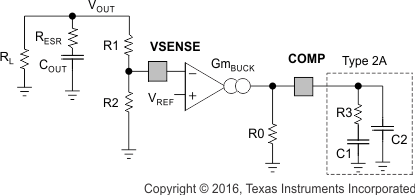 Figure 15. Buck Compensation Components
Figure 15. Buck Compensation Components

Use the standard value of R3 = 24 kΩ,
Where VOUT = 5 V, COUTx = 100 µF, GmBUCK = 1 mS, VREF = 0.8 V
KCFB = 0.125 / RSENSE = 8.33 S (0.125 is an internal constant)

Use the standard value of 1.5 nF.

The resulting bandwidth of buck converter, fC:
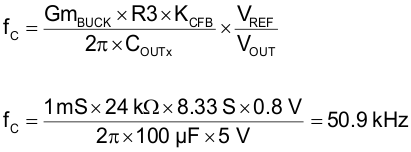
This is close to the target bandwidth of 50 kHz.
The resulting zero frequency fZ1:

This is close to the fC / 10 guideline of 5 kHz.
The second pole frequency fP2:

This is close to the fSW / 2 guideline of 200 kHz. Hence, the design satisfies all requirements for a good loop.
8.2.2.7 Resistor Divider Selection for Setting VOUTA Voltage

Choose the divider current through R1 and R2 to be 50 µA. Then

and

Therefore, R2 = 16 kΩ and R1 = 84 kΩ.
8.2.2.8 BuckB Component Selection
Using the same method as for VBuckA produces the following parameters and components.

This is higher than the minimum duty cycle specified (100 ns typical).
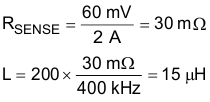
∆Iripple current ≈ 0.4 A (approximately 20% of IOUT max)
Select an output capacitance CO of 100 µF with low ESR in the range of 10 mΩ. Assume fC = 50 kHz.



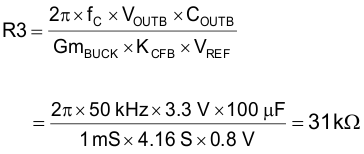
Use the standard value of R3 = 30 kΩ.

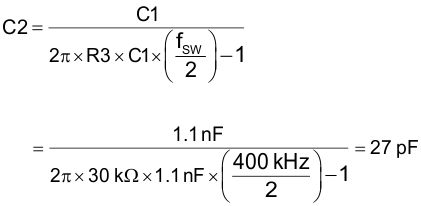
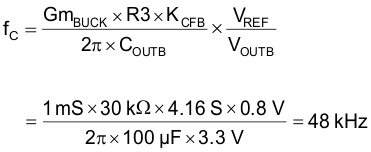
This is close to the target bandwidth of 50 kHz.
The resulting zero frequency fZ1:

This is close to the fC guideline of 5 kHz.
The second pole frequency fP2:

This is close to the fSW / 2 guideline of 200 kHz.
Hence, the design satisfies all requirements for a good loop.
8.2.2.9 Resistor Divider Selection for Setting VOUT Voltage

Choose the divider current through R1 and R2 to be 50 µA. Then

and

Therefore, R2 = 16 kΩ and R1 = 50 kΩ.
8.2.2.10 BUCKx High-Side and Low-Side N-Channel MOSFETs
An internal supply, which is 5.8 V typical under normal operating conditions, provides the gate-drive supply for these MOSFETs. The output is a totem pole allowing full voltage drive of VREG to the gate with peak output current of 1.5 A. The reference for the high-side MOSFET is a floating node at the phase terminal (PHx), and the reference for the low-side MOSFET is the power-ground (PGx) terminal. For a particular application, select these MOSFETs with consideration for the following parameters: rDS(on), gate charge Qg, drain-to-source breakdown voltage BVDSS, maximum dc current IDC(max), and thermal resistance for the package.
The times tr and tf denote the rising and falling times of the switching node and have a relationship to the gate-driver strength of the TPS43350x-Q1 and gate Miller capacitance of the MOSFET. The first term denotes the conduction losses, which are minimal when the on-resistance of the MOSFET is low. The second term denotes the transition losses, which arise due to the full application of the input voltage across the drain-source of the MOSFET as it turns on or off. They are lower at low currents and when the switching time is low.


In addition, during dead time td when both the MOSFETs are off, the body diode of the low-side MOSFET conducts, increasing the losses. The second term in the foregoing equation denotes this. Using external Schottky diodes in parallel to the low-side MOSFETs of the buck converters helps to reduce this loss.
NOTE
The rDS(on) has a positive temperature coefficient, and TC term for rDS(on) accounts for that fact. TC = d × delta T[°C]. The temperature coefficient d is available as a normalized value from MOSFET data sheets and can be assumed to be 0.005 / °C as a starting value.
8.2.3 Application Curves
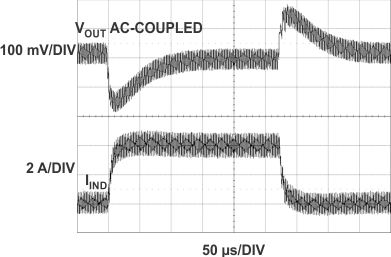
| VIN = 12 V | VOUT = 5 V | fSW = 400 kHz |
| L = 4.7 µH | RSENSE = 10 mΩ |
(0 To 4 A at 2.5 A/µs)
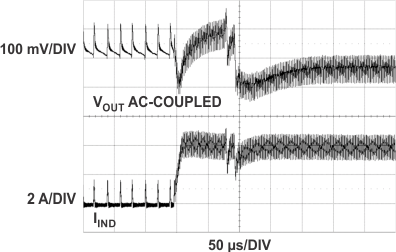
| VIN = 12 V | VOUT = 5 V | fSW = 400 kHz | ||
| LÄ = 4.7 µH | RSENSE = 10 mΩ |
90 mA to 4 A at 2.5 A/µs (Moved Here)
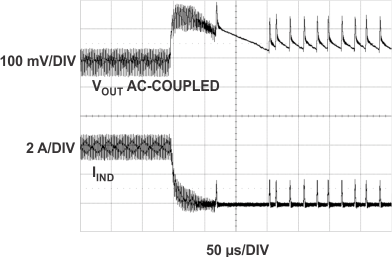
| VIN = 12 V | VOUT = 5 V | fSW = 400 kHz |
| L = 4.7 µH | RSENSE = 10 mΩ |
4 A to 90 mA at 2.5 A/µs (Moved Here)
